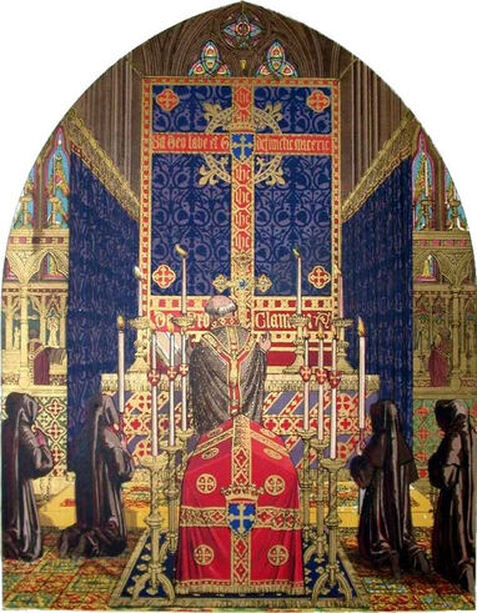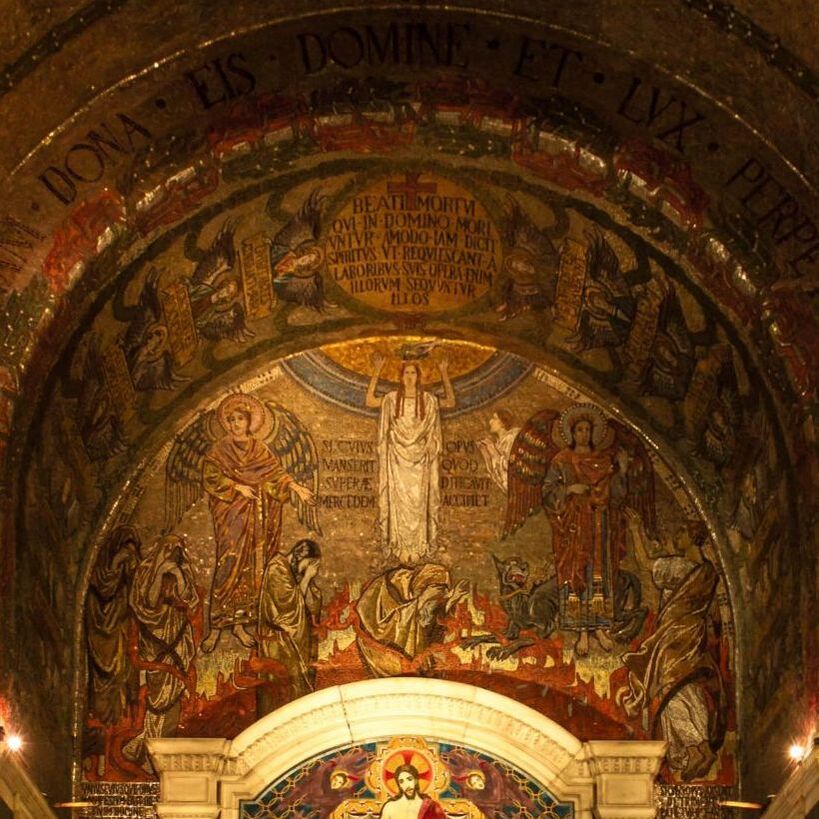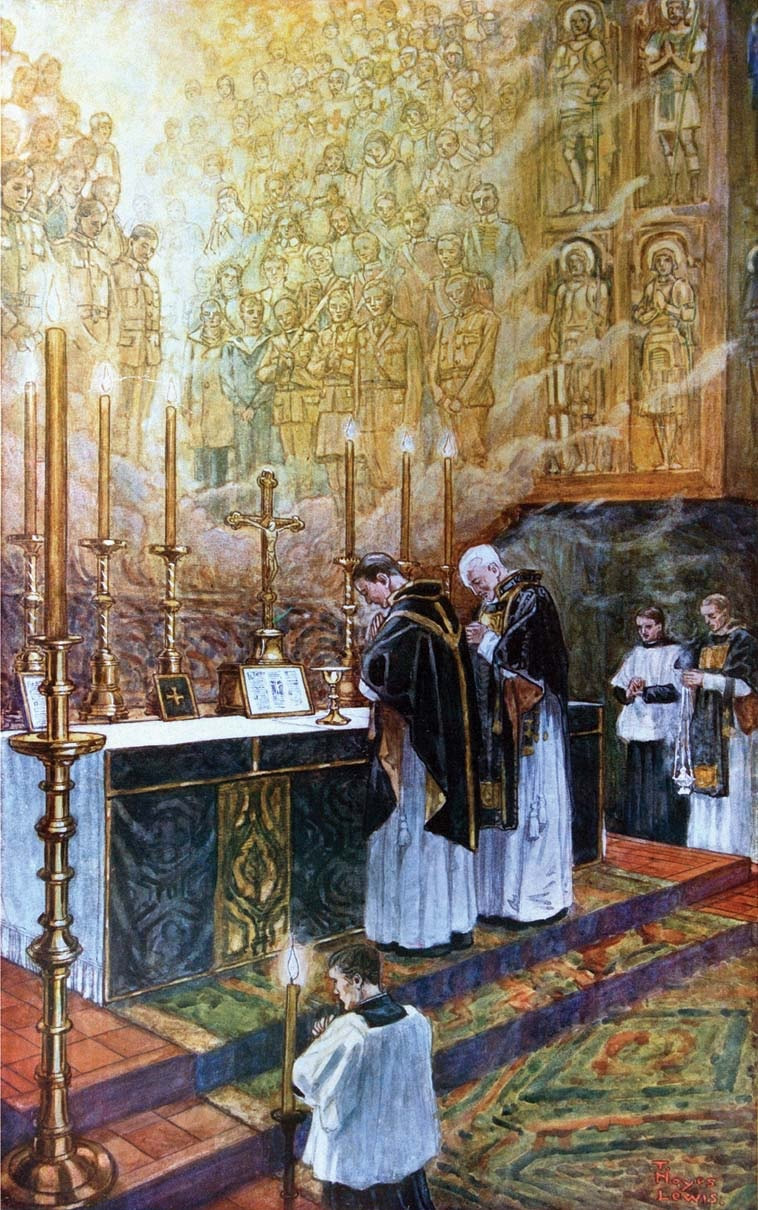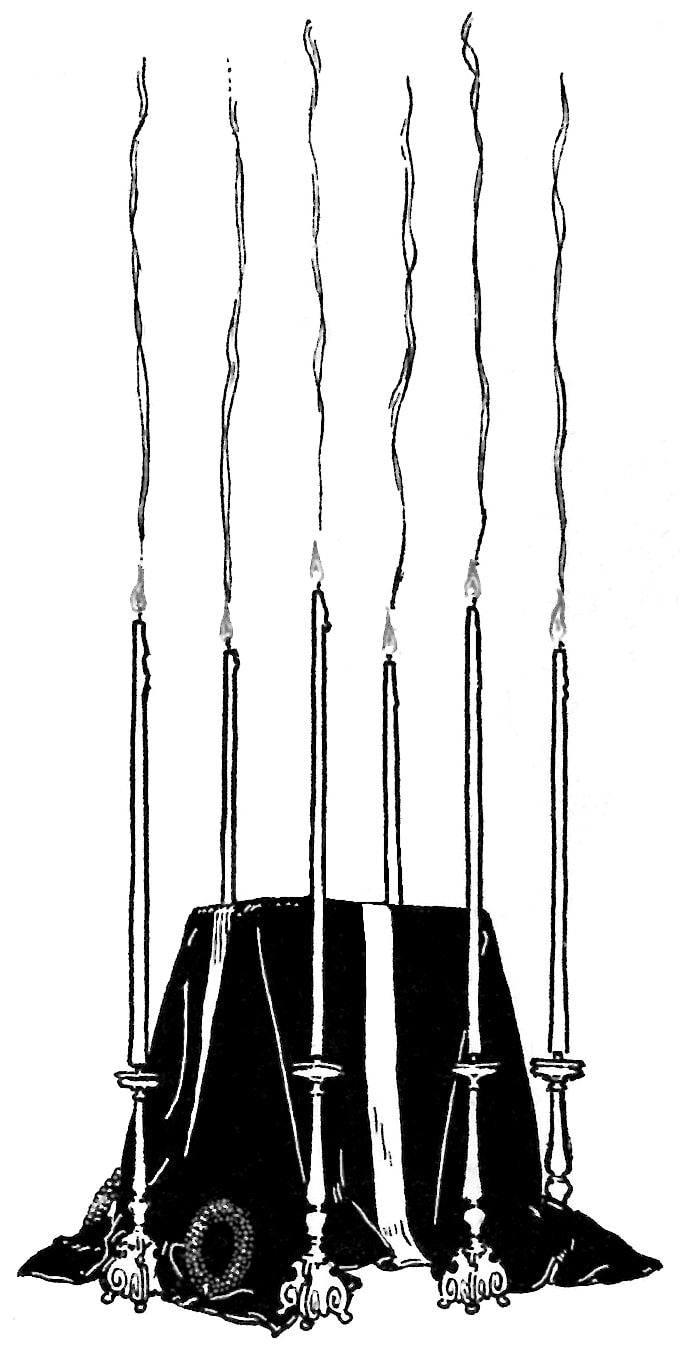The Death Register Form can be downloaded here.
The Request for Special Funeral Arrangements Form can be downloaded here.
In conjunction with this form, please also see: Lections (Requiem Mass) here and Lections (Funeral Service) here.
The Request for Special Funeral Arrangements Form can be downloaded here.
In conjunction with this form, please also see: Lections (Requiem Mass) here and Lections (Funeral Service) here.
Funerals
|
DEATH IS A CONSEQUENCE of original sin - if we had not sinned our bodies would go straight to heaven, as Our Lord did in his Ascension, and Our Lady did at her Assumption. However, since Christ has conquered death on the Cross, our sorrow is tempered by the hope of the Resurrection. We trust that on the last day our mortal bodies will rise again to be with Our Lord.
In her funeral rites, the Church celebrates the Paschal mystery of Christ. Those who in Baptism have become one with the dead and risen Christ will, at the end of their sacramental life, pass with him from death to life, to be purified in soul and welcomed into the fellowship of the saints in heaven. They look forward in blessed hope to his second coming and the bodily resurrection of the dead. After death the effects of sin still remain, which is why most of us will still have to undergo Purgatory - that place and state where the love of God will work to cleanse us and so make us able to enter into God’s presence. We can assist the faithful departed to pass more swiftly through Purgatory by our prayers. |
The greatest prayer we can offer is the Holy Sacrifice of the Mass. A Mass for the dead is called a Requiem - meaning a Mass offered that they may rest in peace.
When someone we love dies there are many things to arrange, and the most important is the person’s funeral. For Catholics a Requiem Mass is offered as the best way of showing our continued love for the deceased. The following notes will help you to prepare and plan for Funeral rites at St John Henry’s.
When someone we love dies there are many things to arrange, and the most important is the person’s funeral. For Catholics a Requiem Mass is offered as the best way of showing our continued love for the deceased. The following notes will help you to prepare and plan for Funeral rites at St John Henry’s.
Anglican Patrimony
|
The texts of the funeral rites in the Ordinariate, Divine Worship: Occasional Services, emphasise that the Eucharist is the heart of the Paschal reality of Christian death, for in that sacrament the Church offers to the Father the saving sacrifice of Christ and commits to the earth the body of the dead person that, pray God, will rise with him in glory. In this way the Ordinariate’s funeral rites underscore that the funeral of a baptised person is normally celebrated within the context of a Funeral Mass.
Whereas the Roman Rite speaks of the prayers for the Commendation of the Dead, Divine Worship celebrates the Absolution at the Bier. |
Order for Funerals from UKOrdinariate on Vimeo |
This title warrants some explanation, so as to avoid a misunderstanding of the term ‘absolution’. The ritual directory of Divine Worship: Occasional Services insists upon the fact that the prayers of Absolution at the Bier are a sacramental. This element is not to be understood as a purification of the dead, much less as effecting a remission of sins, but rather as the last farewell of the Christian community prior to committing the mortal remains of the dead to the earth. ‘Absolution’ understood as purification and forgiveness of sins flows rather from the Eucharistic sacrifice.
When examining the texts themselves, one notes that they preserve the eloquent cadence of traditional English. The adjustments introduced into the text demonstrate the Holy See’s concern that this beautiful language also express the fulness of Catholic faith, particularly here in the expiatory nature of Christ’s sacrifice as applied in the funeral liturgy to the specific soul of the deceased person. The Anglican sources often lacked explicit prayers for the soul of the deceased, preferring a first-person plural form of supplication, praying for the faithfully departed in general with almost a passing reference to the deceased. The commission, Anglicanae traditiones (which worked on supplying ritual texts for the Ordinariate’s liturgy) sought to maintain the centrality of the prayer of supplication for the specific soul of the deceased without compromising the structure or literary integrity of the Anglican sources.
- Bishop Steven Lopes (adapted)
When examining the texts themselves, one notes that they preserve the eloquent cadence of traditional English. The adjustments introduced into the text demonstrate the Holy See’s concern that this beautiful language also express the fulness of Catholic faith, particularly here in the expiatory nature of Christ’s sacrifice as applied in the funeral liturgy to the specific soul of the deceased person. The Anglican sources often lacked explicit prayers for the soul of the deceased, preferring a first-person plural form of supplication, praying for the faithfully departed in general with almost a passing reference to the deceased. The commission, Anglicanae traditiones (which worked on supplying ritual texts for the Ordinariate’s liturgy) sought to maintain the centrality of the prayer of supplication for the specific soul of the deceased without compromising the structure or literary integrity of the Anglican sources.
- Bishop Steven Lopes (adapted)
Preliminaries
|
Planning your funeral before your death is to be highly commended. It eases your own peace of mind before your death, and eases the hearts and minds, too, of those friends and family members who, whilst mourning your loss, will feel more confident in carrying out your wishes if they are, truly, your wishes. Choosing hymns and discussing readings with the Parish Priest can be done at any time, and it’s always wise to have these things written down, signed, and kept on file, even perhaps adding your funeral plans and choices as an attachment to your will.
Funeral Services at St John Henry’s are celebrated according to Divine Worship: Occasional Services, the Ordinariate’s official public liturgy, for members of the Ordinariate only. Funerals for Latin Rite Catholics at St John Henry’s must be celebrated according to the Roman Rite’s Order of Christian Funerals. |
What to do for a Deceased Person after Death
The first step is to speak to the Funeral Directors. Tell them that the deceased person is a Catholic and that you wish to arrange their funeral at St John Henry’s. You should then and fill out a Death Register Form, which can be downloaded at the top of the page, and give it to the Parochial Administrator, Fr Kenyon. The Funeral Directors deal with some costs, but not with those connected to the use of St John Henry’s. Further details are found below.
Who May Recieve a Catholic Funeral?
|
These funeral services are a right, not a privilege, of all members of the Church, both the faithful and the catechumens (CIC 1176; 1183, 1). The Order of Christian Funerals also provides for the celebration of funeral rites for children whose parents intended them to be baptised (CIC 1182, 2). The Ordinary permits funeral rites for a baptised non-Catholic who was not opposed to these rites and whose proper minister is not available (OCF, 18; CIC 1183, 3).
The only persons who are denied ecclesiastical funeral rites and a funeral Mass - provided there was absolutely no sign of repentance before death - are notorious apostates, heretics, and schismatics; those who had chosen cremation for reasons opposed to the Catholic faith; and notorious sinners whose funeral rites would cause public scandal (CIC 1184, 1185). Funeral rites are no longer denied to Masons and members of similar societies, suicides, victims of a duel, those invalidly married, or inactive Catholics. The celebration of a Funeral Requiem Mass is permitted on any day except Solemnities that are Holy Days of Obligation, Thursday of Holy Week (Maundy Thursday), the Paschal Triduum, and the Sundays of Advent, Lent, and Easter. |
Burial or Cremation?
Burial has always been the preferred and normative tradition of the Catholic Church because it expresses more fully the belief in the Resurrection of the Body, and it was the manner in which the Lord willed to be buried. However, cremation is permitted, provided that it is not a deliberate statement contrary to Christian belief. Even if cremation is chosen, it is our preferred practice at St John Henry’s that the cremation take place after the funeral liturgy (whether it be a Funeral Service or a Requiem), so that the funeral can take place in the presence of the body. Cremated remains are always to be buried, or reverently placed in a niche or mausoleum.
A Funeral Service or Requiem Mass is still permitted in the presence of cremated remains. In such cases the urn will be brought into church on the day of the funeral. It is placed on a table in front of the rood screen and covered with a veil. Flowers may be placed next to it.
When a Requiem Mass is to take place in the presence of a body, it is a commendable Catholic practice that the body of the deceased be first brought into church the evening before the funeral, for a short Vigil service. This is usually intended for the closest family members of the deceased person. If you wish this to happen, you should tell the Funeral Directors.
A Funeral Service or Requiem Mass is still permitted in the presence of cremated remains. In such cases the urn will be brought into church on the day of the funeral. It is placed on a table in front of the rood screen and covered with a veil. Flowers may be placed next to it.
When a Requiem Mass is to take place in the presence of a body, it is a commendable Catholic practice that the body of the deceased be first brought into church the evening before the funeral, for a short Vigil service. This is usually intended for the closest family members of the deceased person. If you wish this to happen, you should tell the Funeral Directors.
The Funeral
There are two forms of Funeral rites available: either a Funeral Service (in the presence of the body, or cremated remains), or a Funeral Requiem Mass (in the presence of the body, or cremated remains). In addition, a Vigil for the Deceased (only available when the body is to be brought into church the evening beforehand) is also offered.
The Funeral Service is shorter and consists of the Reception of the Body (if this has not taken place at a Vigil), one or more psalms, a reading, homily, Apostles’ Creed, the Absolution, and prayers. Up to three hymns may be chosen. The choir, soloists and the organist can also play a part. The Committal may follow.
A Funeral Requiem Mass is highly recommended for those who were practising Catholics. It is not possible when one of the parties has not been baptised. All the usual parts of the Mass are present, readings, hymns, and a musical Mass setting. The Committal may follow.
The texts of the Funeral rites are laid down in the Missal. There are some choices which you may make: the readings and the hymns, though these should be discussed with the Parish Priest, who will inform you of the selection available, before any final decisions are made.
Other biblical readings may be chosen, following consultation with the Parochial Administrator. Only readings from Holy Scripture are permitted. If family members of friends wish to read during the Mass they should meet the Celebrant of the Mass beforehand so that he can ensure that they know what to do.
Only sacred music may be used in church. Recorded music is never permitted. The hymns should be from one of the hymn books in use at St John Henry’s – they contain a wide and excellent selection of traditional hymns. No secular music is permitted. The organ may also be used, and a suitable organ prelude and postlude can be chosen.
The parish will produce the order of service. This will include the texts of the liturgy, the hymns and the readings. Phrases such as ‛Celebration of the life of...’ or ‘Thanksgiving for the life of...’ do not reflect Christian belief, and will not be used. Our principal purpose at a Requiem Mass is to pray for the repose of the soul of the deceased person.
It is advised that you select two Sidesmen to distribute orders of service and to direct guests to their places in church.
No eulogies are permitted whatsoever. The Celebrant of the Requiem Mass will preach a homily and may make some brief remarks about the life of the deceased person. However, the main purpose of the homily is to preach the Gospel and to instil in us the hope of the Resurrection.
The Funeral Service is shorter and consists of the Reception of the Body (if this has not taken place at a Vigil), one or more psalms, a reading, homily, Apostles’ Creed, the Absolution, and prayers. Up to three hymns may be chosen. The choir, soloists and the organist can also play a part. The Committal may follow.
A Funeral Requiem Mass is highly recommended for those who were practising Catholics. It is not possible when one of the parties has not been baptised. All the usual parts of the Mass are present, readings, hymns, and a musical Mass setting. The Committal may follow.
The texts of the Funeral rites are laid down in the Missal. There are some choices which you may make: the readings and the hymns, though these should be discussed with the Parish Priest, who will inform you of the selection available, before any final decisions are made.
Other biblical readings may be chosen, following consultation with the Parochial Administrator. Only readings from Holy Scripture are permitted. If family members of friends wish to read during the Mass they should meet the Celebrant of the Mass beforehand so that he can ensure that they know what to do.
Only sacred music may be used in church. Recorded music is never permitted. The hymns should be from one of the hymn books in use at St John Henry’s – they contain a wide and excellent selection of traditional hymns. No secular music is permitted. The organ may also be used, and a suitable organ prelude and postlude can be chosen.
The parish will produce the order of service. This will include the texts of the liturgy, the hymns and the readings. Phrases such as ‛Celebration of the life of...’ or ‘Thanksgiving for the life of...’ do not reflect Christian belief, and will not be used. Our principal purpose at a Requiem Mass is to pray for the repose of the soul of the deceased person.
It is advised that you select two Sidesmen to distribute orders of service and to direct guests to their places in church.
No eulogies are permitted whatsoever. The Celebrant of the Requiem Mass will preach a homily and may make some brief remarks about the life of the deceased person. However, the main purpose of the homily is to preach the Gospel and to instil in us the hope of the Resurrection.
Symbols Used in a Requiem MassBlack vestments are worn as a symbol of grief. Six unbleached candles stand around the coffin. The altar may be dressed in violet.
The coffin is sprinkled with holy water as a reminder of Baptism, and the paschal candle also stands nearby as a symbol of the Resurrection. The coffin should usually have a crucifix on it. It will also be covered with a black pall, which is decorated with the cross. Although during most of the Church Year flowers are placed in church around the altar to express joy, they are not used at Funerals or Requiem Masses. One flower arrangement may also sit atop the coffin, but other items should not go there, as they would distract from the Christian symbols and make too much of a distinction between different people. |
Costs
A donation is always welcome for the maintenance and upkeep of the church, but this is at your discretion. In the case of non-parishioners an offering of $500 is expected to pay for preparation, cleaning, lighting and heating. Please understand that it is not a fee, and it may be reduced or waived in cases of hardship.
For musical costs please contact the Director of Music, Scott Vannan, at scottvannan@hotmail.com or 250.818.3796.
For musical costs please contact the Director of Music, Scott Vannan, at scottvannan@hotmail.com or 250.818.3796.




